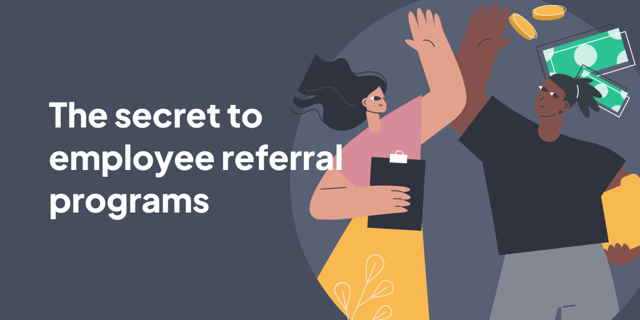Hiring is a tedious process. From securing a pool of applicants and filtering through endless resumes to scheduling interviews, finding reliable employees can feel like a full-time job. How do you find reliable applicants faster?
Starting an employee referral program is a great strategy. Referred applicants are less likely to turnover and more likely to be high performers. Having a referral program in place allows your employees to be an additional layer of filtering in the hiring process, where they can help in determining whether the job would be a good fit for the candidate and vice versa.
Your employees are the best ambassadors for your business because they know how the company functions and what personalities and characteristics are the best fit for your company culture. Ever heard of the saying birds of a feather flock together? By tapping into your employees’ network, you increase the chances of getting more applicants with similar characteristics as your current employees, as they’re likely to befriend people similar to themselves. This means if your employee is hardworking or detail-oriented, the person they refer could have similar characteristics too.
On the flip side, they can also determine if their friends or family members have the skills and work ethic you’re looking for. This means they’re more likely to recommend applicants suited for the role and will also be careful about who they refer because their reputation is also on the line.
Do you need an employee referral program?
Before you go buying gift cards and telling your employees to refer their friends, take a step back to consider your business case and any potential legal issues.
Ask yourself these questions:
- How many hours could you save in recruiting by having a referral program in place?
- What are the cost savings?
- What are the costs necessary to put a referral program in place?
Weigh the pros, cons, and costs to evaluate if this is the right move for your hiring strategy—and to help get buy-in from others involved in your hiring process if needed.
Also look into the legalities. Do you have an in-house legal counsel, and if not, should you consider having one? Legal counsel is important to ensure you’re building your program fairly and avoiding unintentional discrimination. Think of potential loopholes or areas that could be questioned. Ensure the referral program is open to the entire organization, all candidates will be screened equally, and fair recruiting methods are employed when sharing about new openings in the organization.
Building an employee referral program
A successful employee referral program is clearly defined, easy to follow, and optimized often. These are the five steps you should take to build a well-rounded and impactful program.
- Define the objectives
- Determine the process
- Decide on the incentive
- Collect feedback and review
- Amplify the program
Define the objectives
As an HR leader or hiring manager, ask yourself what your goal for the hiring program is. This helps you form the foundation of the program, how the process is structured, and what goals have to be met. Is your goal to hire X more employees a month? Or to increase employee retention by X months? Or to improve the culture fit of new employees?
Once you’ve identified your program’s goals, you can tie it to outcomes like lower recruitment costs, fewer hours devoted to hiring, a higher percentage of accepted job offers, higher quality applicants, and more. These are all important metrics to track especially in the review stage because it allows you to determine the effectiveness of your referral program.
Determine the process
Referral programs should be as straightforward as possible because the last thing you want to do is deter employees from making a referral. Use the following questions to determine your process.
How should you collect referrals?
- Employees could submit referrals through a form
- Some intranet portals enable employees to submit referrals
- Employees can make email introductions between you and their referee
- You can include a section in job applications that allows applicants to fill in the name and email address of their referrer.
What information should you collect?
If you're collecting referrals through your applications, an applicant tracking system will manage your referrals for you. If you're using an alternative method listed above, be sure to collect all the information you need about the referee (name, email address, phone number) and the referrer (name, email address, phone number, employee number, location, etc.).
Will you fast-track applications?
Another question to consider is whether or not you will fast-track referred applicants. Do they get to skip a round of interviews, or do they go through the same hiring process as other applicants?
Who can refer applicants?
Some organizations restrict HR employees from participating due to a conflict of interest. Many organizations limit their programs to full-time, permanent employees, and exclude temporary employees. Clearly indicate the terms and conditions of your program so your employees know who can participate and what is considered a successful referral, such as when they can expect to receive an incentive (if this is X days after the new hire's first day, or after they have passed their new hire probation period).
How will you announce and promote your referral program?
Tell your team in company-wide emails, during shift meetings, or even via your intranet or bulletin board. Think about how to market this to external candidates as well, as it could be considered an attractive employee benefit. It should also be part of the new hire onboarding process so all employees are aware of the program and know how to participate. Communication should be ongoing.
Decide on the incentive
Referral programs often come with an incentive to reward employees when their referee is offered the job. You may choose to go with a standard referral bonus or non-cash incentives like an extra day off, charity donations, food treats, or even recognition. Consider your incentive based on your budget and what you know about motivating your team.
Incentives can even differ based on the type of role you’re hiring for. An employee who helped fill a harder-to-fill position could receive a larger referral bonus. Determine if a one-off payment, which is more commonly done, or a split payment works better for your organization. One-off payments are often processed once the new hire has been onboarded. Split payments are broken out into two cycles: after the new hire has been onboarded and when they’ve completed their probation period.
Collect feedback and review
After a month or two of running your employee referral program, begin asking for feedback and conducting reviews. This allows you to identify if the referral program is meeting the goals and objectives set in step 1.
Review:
- Goals and objectives: Keep track of referrals to determine long-term goals such as retention and culture fit.
- Process: Do employees find it hard to use the system? Did anyone have issues receiving the incentive? How can you make the process more streamlined?
- Incentives: Have there been sufficient referrals? If not, consider looking into better incentives to motivate employees. You can even ask them!
- Metrics: Look at the number of employees hired from the referral program as opposed to other recruiting methods, the employee participation rate, your new hire retention rate, etc.
Constantly reviewing your referral program allows you to find areas for improvement and sometimes even uncover examples of employees abusing the system that you need to address.
Amplify the program
Now that you’ve launched and optimized your employee referral program, it’s time to increase its reach. Here are some ways to take your program up a notch:
- Accept referrals all the time instead of only when you have an active open position. This enables you to build a solid pool of applicants you can tap into when a position does open. Just remember to ask permission to keep an applicant’s resume on file.
- Have open communication with the employees and the candidates on the status of their referrals to build trust and provide a positive experience for both parties. This encourages both the referrer and the referee to participate again should the opportunity arise.
- Share feedback on their referrals with your employees, such as their strengths and weaknesses and why their referral got accepted or rejected. This helps your employees learn what you’re looking for and helps them communicate with their friend or family member if they don't get the job.
- Have an efficient hiring process and evaluate candidates quickly to prevent losing them to other companies in the hiring process due to slow or no response
The right HR technology makes managing your applicant pool easier. Explore the features that have the biggest impact on streamlining your hiring process.



